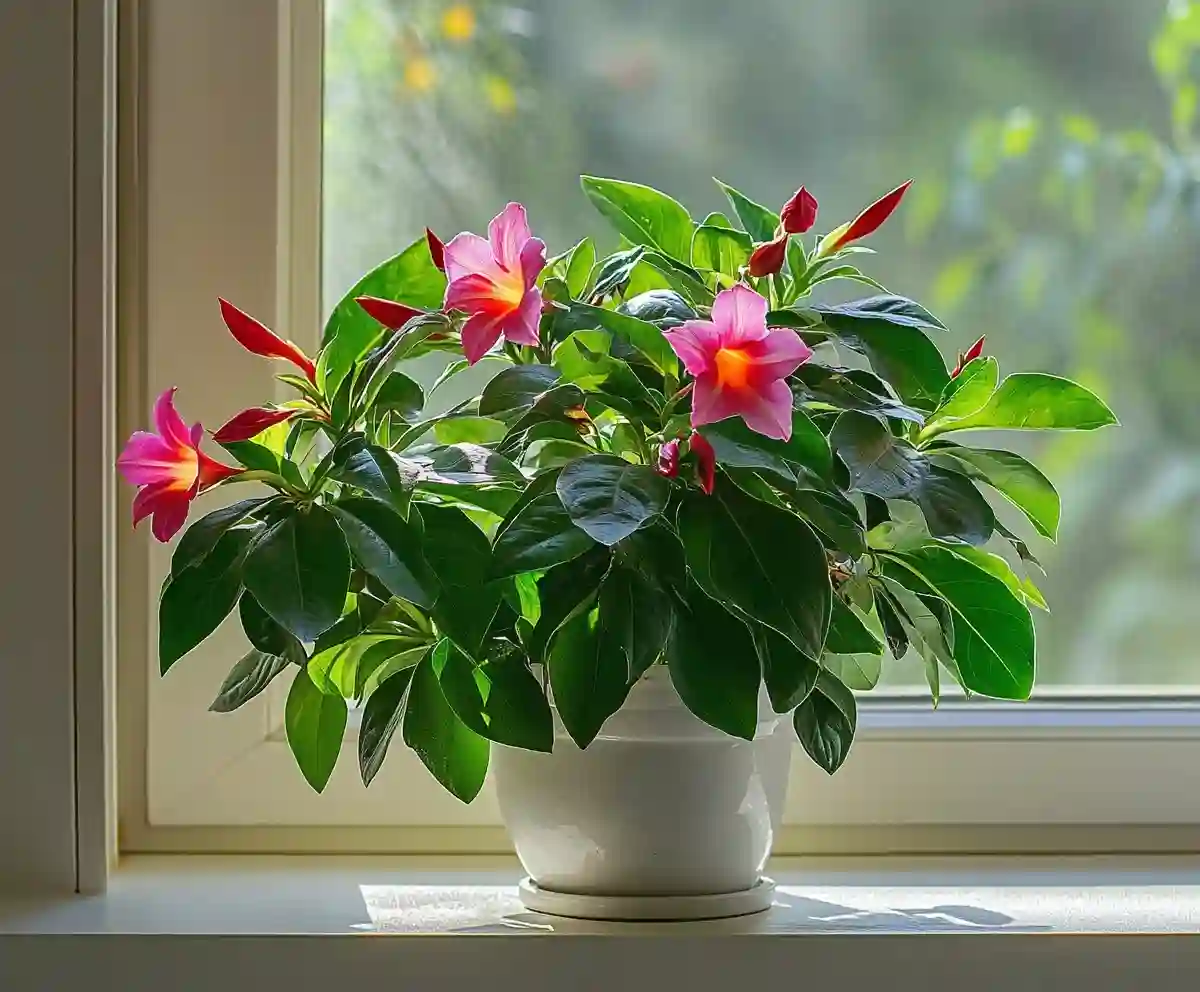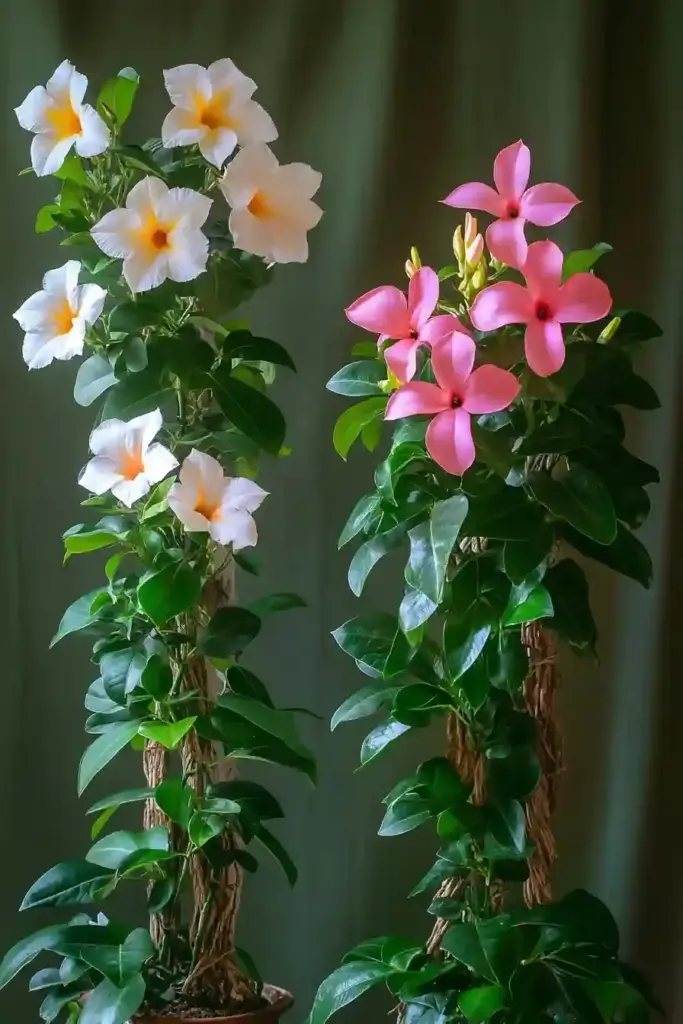Looking to add a splash of tropical flair to your indoor garden? Dipladenia, often called Brazilian jasmine, is a lush and colorful plant that rewards you with trumpet-shaped blooms and glossy green foliage. Whether you’re a new plant parent or a seasoned gardener, mastering dipladenia plant care can help you enjoy vibrant flowers from spring through fall—right from your living room.
In this complete guide, we’ll walk you through everything you need to know to help your dipladenia thrive indoors—from lighting and watering to pruning and propagation. Let’s dive in and bring the tropics home!
Dipladenia vs. Mandevilla – What’s the Real Difference?
If you’ve ever browsed garden centers or plant shops, you’ve probably noticed dipladenia and mandevilla often sitting side by side—sometimes even labeled as the same plant. While they’re closely related, there are a few key differences that matter, especially when you’re growing them indoors.
🔍 Same Family, Different Growth Style
- Dipladenia is a compact, shrubby plant. It tends to grow outward and downward, making it perfect for containers, hanging baskets, or smaller indoor spaces.
- Mandevilla, on the other hand, is a vigorous climber. It sends out long, vining stems that need a trellis or support to stay upright.
So, if you want a manageable, tidy plant for a shelf or windowsill, dipladenia is your go-to. Prefer dramatic vines climbing up a trellis? Mandevilla fits that bill.
🌱 Leaf and Flower Differences
- Leaves: Dipladenia has smaller, glossy leaves that feel smooth and stay densely packed. Mandevilla’s leaves are often larger and can feel slightly leathery.
- Flowers: Both produce bold, trumpet-shaped blooms in vibrant reds, pinks, and whites. Mandevilla flowers may be larger, but dipladenia makes up for it by producing more blossoms at once.
🏡 Which is Better Indoors?
For most indoor gardeners, dipladenia is the better choice. Its compact growth makes it easier to manage in containers, and it doesn’t demand much space or support. However, both can thrive indoors with proper care—the key is tailoring your space to the plant’s natural growth habit.
💡 Quick Tip: If you’re unsure what you have, just watch how it grows. Vining = mandevilla. Bushy = dipladenia.
Popular Types and Varieties of Dipladenia for Indoor Gardens
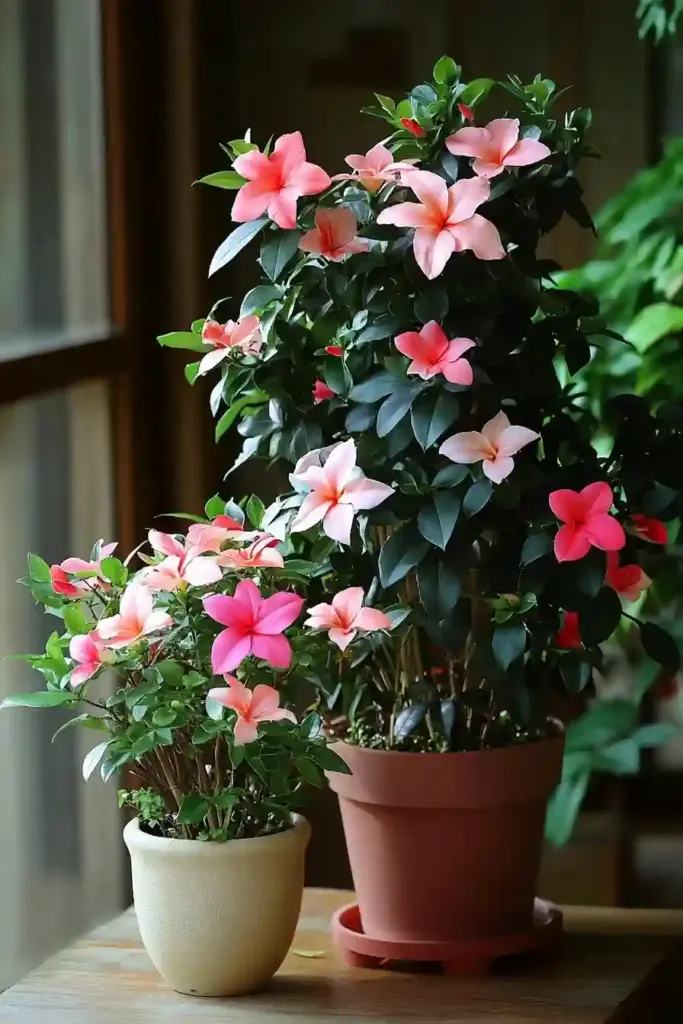
When choosing a dipladenia for your home, variety matters! Some cultivars are more compact, flower more profusely, or offer unique colors and foliage. Here are some of the most loved and indoor-friendly dipladenia varieties to brighten your space:
🌺 Rio® Series (Mandevilla sanderi)
- Compact and bushy—perfect for small pots or tabletops
- Blooms in bold red, bright pink, and snow white
- Known for continuous flowering and low maintenance
- Ideal for beginners or anyone short on space
🌸 Sun Parasol® Series
- Includes both dwarf dipladenia types and climbing mandevillas
- Features larger, show-stopping blooms (up to 4 inches!)
- Available in vibrant shades like crimson, deep pink, and apricot
- Choose “garden” or “dwarf” types for compact, container growth
❤️ ‘Red Riding Hood’ Dipladenia
- A classic favorite with rosy-red blooms
- Has a rounded, mounding growth habit—easy to maintain indoors
- Stays under 3 feet tall, making it perfect for medium-sized planters
- Foliage sometimes has a subtle bronze tint for added interest
🍃 Variegated & Specialty Hybrids
- ‘Fire and Ice’: Striking green-and-white foliage with red flowers
- Mandevilla laxa: Fragrant white flowers, more vine-like but still indoor-friendly
- Great for plant parents who love unique leaf patterns or fragrances
🛒 Pro Tip: When shopping for dipladenia, look for full, glossy leaves and visible buds. Avoid plants with yellowing leaves or dry soil—they may be stressed.
Ideal Indoor Growing Conditions for Dipladenia
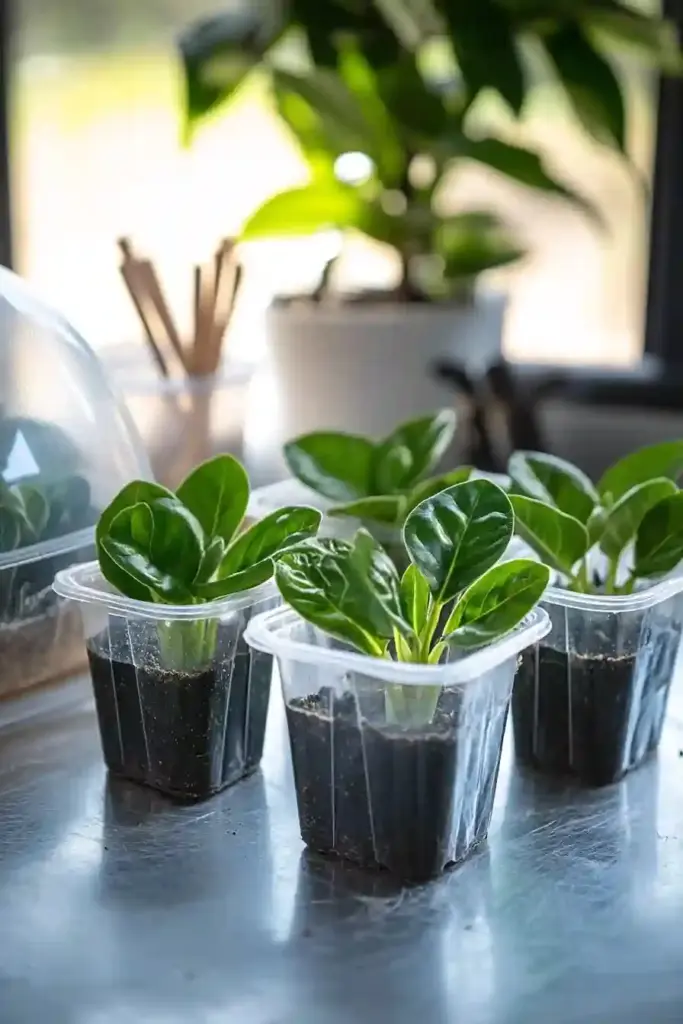
Creating the right environment is key to healthy growth and vibrant blooms. While dipladenia is a tropical plant, it adapts surprisingly well to indoor life when you mimic its natural habitat. Here’s what it needs:
☀️ Light Requirements
- Bright, indirect light is essential. Place your dipladenia near a south- or west-facing window for at least 6–8 hours of light per day.
- It can tolerate some direct morning or late afternoon sun, but avoid harsh midday rays which can scorch the leaves.
- In low-light settings? Use a grow light to supplement sunshine and keep those blooms coming.
🔆 Signs it needs more light: Sparse flowers, leggy stems, or leaves turning pale.
🌡️ Temperature and Humidity
- Ideal temperature: 65–85°F (18–29°C). Keep it away from chilly drafts, air conditioners, or heaters.
- No frost, please: Anything below 50°F (10°C) can damage your plant.
- Humidity sweet spot: Moderate to high (40–60%). If your home is dry, especially in winter:
- Use a humidifier nearby
- Set the pot on a pebble tray with water
- Group it with other plants to raise local humidity
🪴 Soil Mix and Potting
- Use a well-draining, loose potting mix. A good formula:
- 2 parts all-purpose potting soil
- 1 part perlite or coarse sand
- 1 part coco coir or peat moss
- pH preference: Slightly acidic to neutral (6.0–7.0).
- Always use pots with drainage holes to prevent root rot.
- Dipladenia actually thrives when slightly root-bound, so don’t rush to repot.
🌱 When to repot: Every 1–2 years in spring, or when roots peek out of the bottom.
🌿 Container and Support
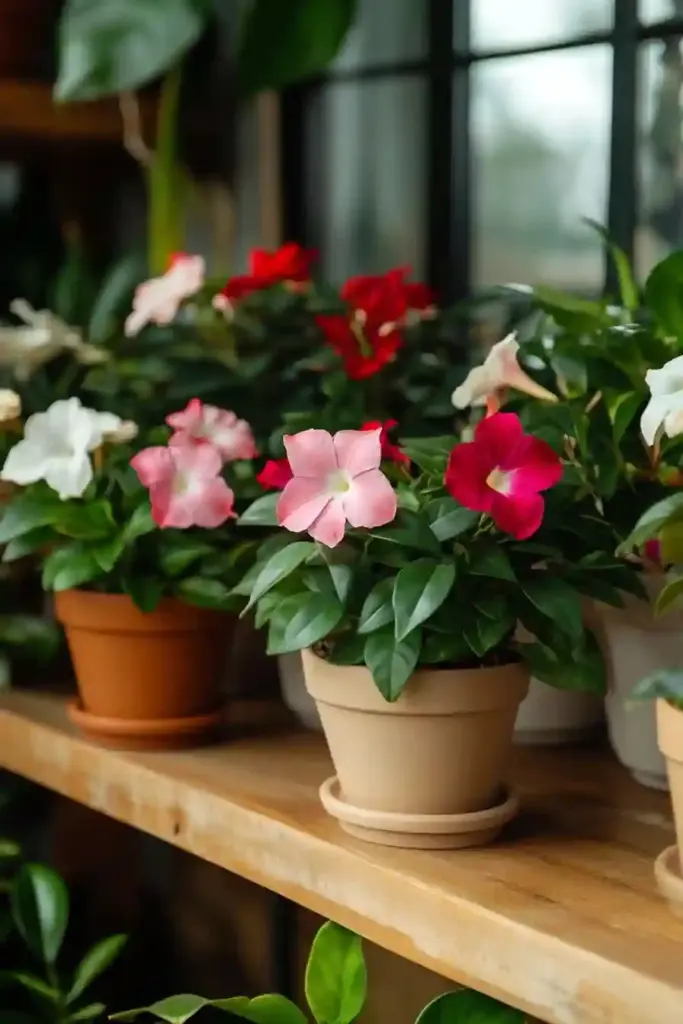
- Choose a sturdy container that won’t tip over as the plant grows.
- Though dipladenia is bushier than mandevilla, light support like a mini-trellis or hoop can help shape and tidy growth.
- For a trailing look, try a hanging basket or elevated planter and let stems cascade.
Watering and Feeding Your Dipladenia Indoors
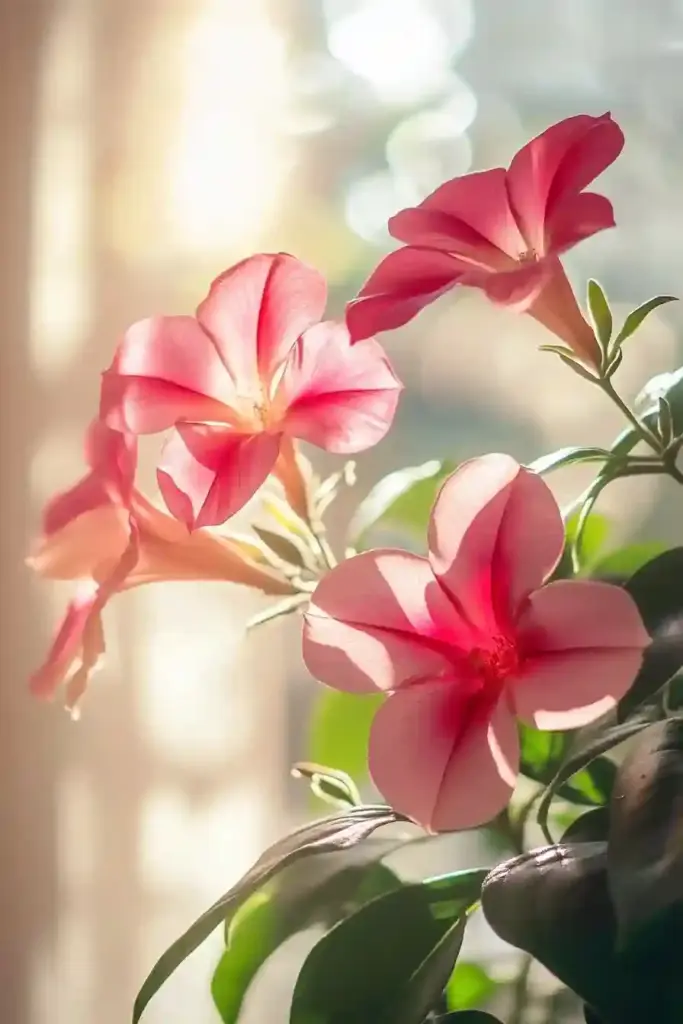
One of the most important elements of dipladenia plant care is mastering the right balance between watering and fertilizing. Too much or too little of either, and your plant could sulk—or worse, stop blooming altogether. Here’s how to get it just right:
💧 How to Water Dipladenia (And How Often)
- Water when the top 1–2 inches of soil feel dry. Use your finger to test—if it feels dry, it’s time to water.
- On average, expect to water about once a week in warm seasons and every 10–14 days in cooler months.
- Always water thoroughly, letting excess drain from the pot. Never let your dipladenia sit in water—root rot is real!
🕵️♀️ Watch for Watering Warnings:
- Drooping + dry soil = underwatered
- Yellowing leaves + soggy soil = overwatered
- Bud drop = inconsistent watering or root stress
⚠️ Tip: If you’re using a decorative pot with no drainage, always water carefully and empty any collected water immediately.
🍽️ Feeding for Flowers
- Fertilize monthly during the growing season (spring to early fall).
- Use a balanced liquid fertilizer (e.g., 10-10-10) or a bloom booster (like 10-20-10) for extra flower power.
- Feed on moist soil to avoid burning the roots.
Alternative: Use slow-release fertilizer pellets when repotting in spring for hands-off feeding all season.
🌼 No blooms? Try switching to a fertilizer with more phosphorus (the middle number). Still no luck? It might need more light instead.
🚫 Skip Fertilizer in Winter
Dipladenia slows down in the cold months. Don’t feed it during this time—it won’t absorb nutrients well and excess salts can build up in the soil.
Pruning and Training Dipladenia for Indoor Growth
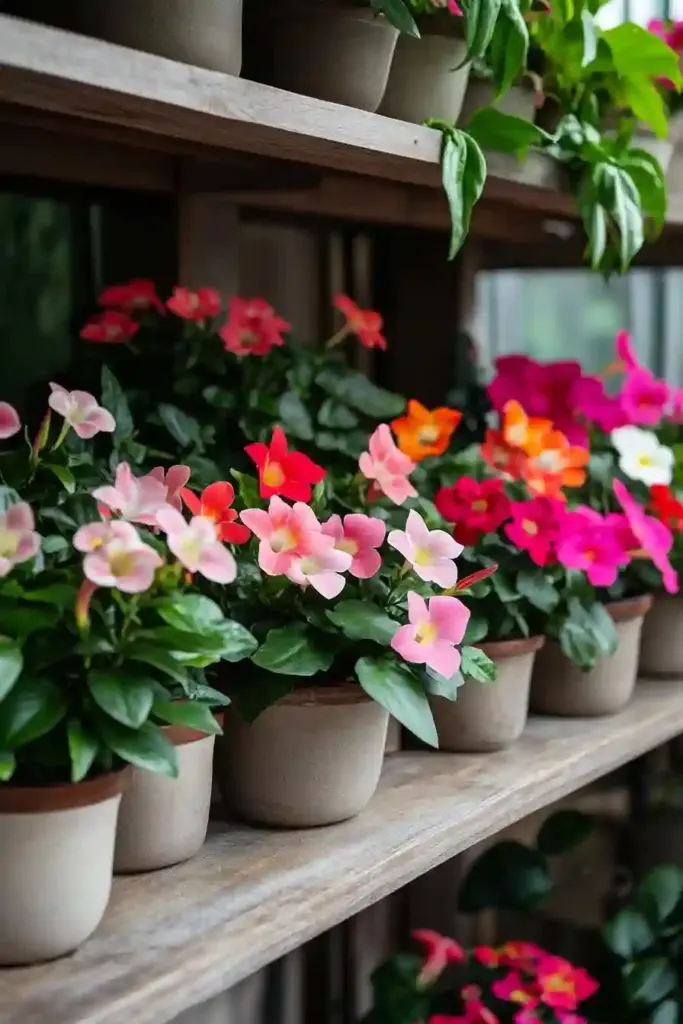
While dipladenia naturally maintains a fairly compact shape, a little regular pruning and training goes a long way—both for appearance and for more blooms. Think of it as grooming your plant to look (and feel) its best.
✂️ Why and When to Prune
- Encourages fuller, bushier growth
- Stimulates new flowering branches (flowers grow on new growth!)
- Keeps size in check for indoor containers
- Removes dead or damaged stems
🗓️ Best time to prune:
- Early spring before the growing season kicks in
- Light pruning or deadheading can be done anytime during the year
🌿 Pinch or snip back long stems regularly to maintain shape and stimulate side shoots.
🪴 How to Prune Properly
- Use clean, sharp scissors or pruners
- Cut just above a leaf node (where a leaf meets the stem)
- Remove yellowing, leggy, or dead stems
- Don’t be afraid to cut back by half in spring if the plant looks overgrown—dipladenia responds well to a reset
🌱 Training for Shape and Style
Depending on your space and aesthetic, you can guide your dipladenia into various forms:
👉 Upright & Structured
- Add a small trellis, hoop, or stake to the pot
- Gently tie longer stems using soft garden ties or twist ties with padding
- Ideal for creating a tidy, columnar or bushy shape
👉 Trailing & Cascading
- Let stems spill over a hanging basket or elevated shelf
- Great for a more natural, free-form look
- Still trim occasionally to prevent it from becoming sparse or straggly
🔄 Maintenance Tips
- Rotate the pot weekly to prevent leaning toward the light
- Wipe leaves gently with a damp cloth to remove dust and help photosynthesis
- Keep an eye out for any weak, damaged, or tangled stems and snip them off
🌼 Bonus: After pruning, you’ll often see a burst of new shoots—each a potential bloom site!
How to Encourage Dipladenia to Flower Indoors

Let’s be honest—the main reason we love dipladenia is for those tropical, trumpet-shaped flowers that light up our homes. But how do you make sure your plant keeps blooming? It comes down to a few essential care techniques.
🌸 Dipladenia’s Indoor Blooming Cycle
- Spring to early fall: Peak blooming season with proper care
- Fall to winter: Slows down or may stop blooming—this is totally normal
- Winter blooms? Possible with strong light and warm temps, but most plants take a rest
✨ Goal: Encourage steady growth and bud formation during the long daylight months, and accept the slower pace during winter.
🌞 Top Tips to Promote Lush, Continuous Blooms
1. Maximize Light
- Light = Flowers. Dipladenia needs at least 6–8 hours of bright light daily.
- Best spot? South or west-facing window, or use a grow light if needed.
- Without enough light, you’ll get leaves but no flowers.
2. Feed for Flowers
- Use a phosphorus-rich fertilizer (like 10-20-10) once a month during the growing season.
- Don’t overdo it—too much fertilizer (especially nitrogen) can lead to lots of foliage and few flowers.
3. Prune Smart
- Prune early in the season to encourage new branches, which is where flowers form.
- Avoid heavy pruning during mid-summer, as it could remove developing buds.
4. Stable Environment
- Avoid temperature swings, cold drafts, or excessive heat.
- Aim for a consistent indoor range of 65–85°F (18–29°C).
- Keep soil evenly moist, especially when the plant is budding. Too much stress = dropped buds.
🚫 Common Blooming Problems (And Fixes)
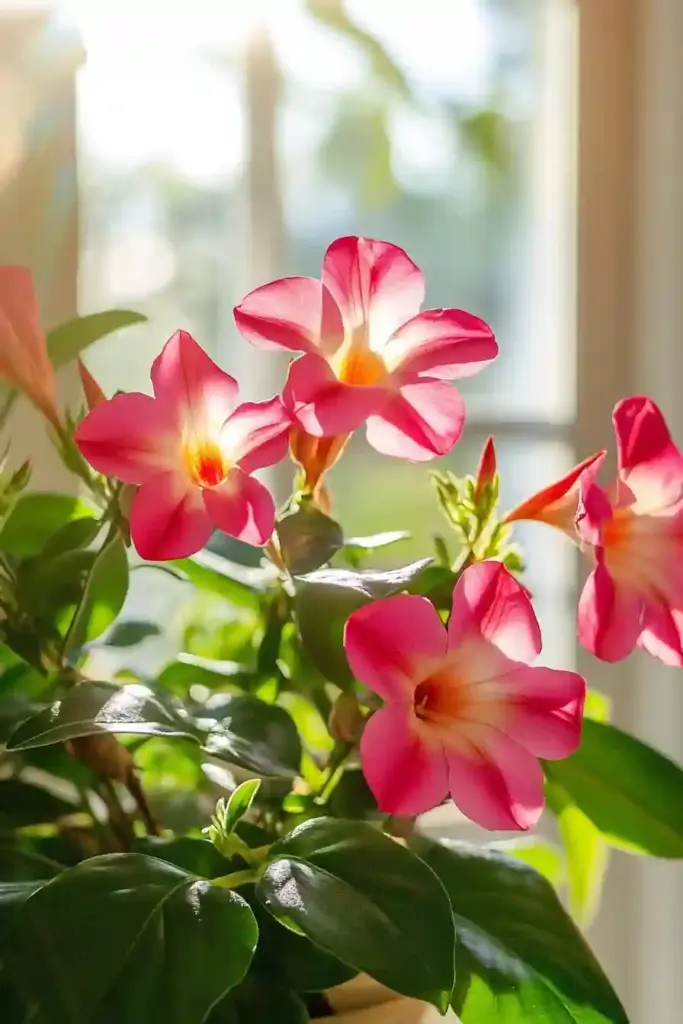
| Problem | Likely Cause | Quick Fix |
|---|---|---|
| All leaves, no blooms | Not enough light | Move to a brighter spot |
| Buds falling off | Drafts, dryness, or shock | Keep conditions steady |
| Sparse flowers | Low phosphorus or poor pruning | Adjust feeding and shape early in season |
| Blooms fading fast | Too hot, dry, or poor humidity | Improve indoor conditions, mist occasionally |
🌼 Tip: Deadhead faded flowers to tidy up and encourage new blooms.
Common Dipladenia Problems and How to Fix Them
Even with great care, your dipladenia might throw you a curveball now and then. But don’t panic—most issues are easy to solve once you know what to look for. Here’s a handy troubleshooting guide for the most common dipladenia care problems indoors.
🍃 Yellow Leaves
What it means:
- Overwatering is the most common culprit
- Could also be underwatering, nutrient deficiency, or natural aging of lower leaves
Fix it:
- Check soil moisture—if soggy, let it dry out more between waterings
- Ensure your pot has good drainage
- If new leaves are yellowing, feed lightly with a balanced fertilizer
🥀 Wilting or Drooping
What it means:
- Either too dry or too wet
- Sudden wilting might also come from a draft or transplant shock
Fix it:
- Water thoroughly if soil is dry
- If soil is wet, improve airflow and let it dry out
- Move the plant away from cold spots or AC vents
❌ No Blooms
What it means:
- Usually not enough light
- Overfeeding with high-nitrogen fertilizer can also lead to leafy growth but no flowers
Fix it:
- Move it to a sunnier spot or add a grow light
- Switch to a phosphorus-rich bloom booster
- Trim back leggy growth to stimulate new flowering stems
🌱 Leggy, Sparse Growth
What it means:
- Light is too low
Fix it:
- Increase light exposure
- Prune stems back to promote bushier growth
🐛 Pest Problems
Common indoor pests on dipladenia:
- Spider mites (webbing, speckled leaves)
- Mealybugs (white cottony clumps)
- Aphids (tiny insects on buds)
- Scale (small brown bumps on stems)
Fix it:
- Spray with neem oil or insecticidal soap
- Wipe leaves gently with a damp cloth
- Isolate the plant if pests spread
🧼 Prevention tip: Keep leaves clean and regularly inspect under foliage to catch pests early.
🌬️ Sudden Leaf Drop
What it means:
- Drastic change in light or temperature
- Could also be dry air or seasonal dormancy
Fix it:
- Keep environment consistent and draft-free
- Mist or boost humidity if air is dry
- Trim bare stems and wait—it usually rebounds
By catching and correcting issues early, you’ll help your plant bounce back quickly and stay in top form.
Propagation Tips – Grow New Dipladenia Plants from Cuttings
Want more dipladenia plants around your home—or to gift to a fellow plant lover? The good news is, propagating dipladenia from stem cuttings is easy, fun, and rewarding. Here’s a simple step-by-step guide to multiplying your tropical beauty.
✂️ When to Propagate
- Best time: Spring to early summer, when the plant is actively growing
- Avoid propagating during winter or dormancy—success rates are lower
🪴 What You’ll Need
- Clean, sharp scissors or pruning shears
- Small pots with well-draining propagation mix (e.g. peat + perlite)
- Optional: Rooting hormone
- Clear plastic bag or humidity dome
- Spray bottle for misting
🌱 Step-by-Step: How to Propagate Dipladenia
1. Take a Cutting
- Choose a healthy, non-flowering stem about 4–6 inches long
- Cut just below a leaf node (where leaves meet the stem)
2. Remove Lower Leaves
- Strip off the leaves on the bottom half of the cutting
- Keep 2–3 smaller leaves at the top
3. (Optional) Dip in Rooting Hormone
- Improves success rate and speeds up root development
- Just dip the base of the stem lightly into the powder or gel
4. Plant the Cutting
- Insert into moist propagation mix about 2–3 inches deep
- Gently press soil around it to keep it upright
5. Create Humidity
- Cover the pot loosely with a clear plastic bag to trap moisture
- Keep the bag from touching the leaves—use sticks if needed
- Place in bright, indirect light (not direct sun)
6. Wait and Watch
- Mist soil lightly to keep it moist but not soggy
- Open the bag daily for a few minutes to prevent mold
- Roots should form in 2–4 weeks
🌿 What’s Next?
- Once rooted, gently transplant to a small pot with regular potting mix
- Give it time to adjust, then treat it like your mature dipladenia
- New plants may bloom in their first season if started early enough
✨ Tip: Not every cutting will succeed, so take a few at once. Dipladenia sap can be irritating—wear gloves if you have sensitive skin.
❓ Frequently Asked Questions
Q: Is dipladenia the same as mandevilla?
A: They’re related! Dipladenia is a bushier, more compact form within the mandevilla family. Perfect for pots and smaller indoor spaces.
Q: Can dipladenia grow indoors year-round?
A: Absolutely! Just make sure it gets plenty of light and warmth. It may rest in winter but will bounce back in spring.
Q: How do I make it bloom more?
A: Focus on three things: bright light, bloom-boosting fertilizer, and early-season pruning. These are the magic ingredients for more flowers.
Q: Is it safe for pets?
A: Dipladenia is considered mildly toxic if ingested and its sap may irritate skin. Keep out of reach of pets and children, and wear gloves when pruning.
🌟 Quick Indoor Care Tips for Dipladenia
- 🪟 Bright light = more flowers. South- or west-facing windows are best
- 💧 Water only when the top inch of soil is dry
- 🧴 Fertilize monthly in spring and summer with a bloom formula
- ✂️ Prune in early spring for shape and flowering
- 🌬️ Keep away from cold drafts or heat vents
- 🧼 Wipe leaves and inspect for pests during watering
- 🌱 Propagate in spring for more plants!
🏁 Conclusion
With its tropical blooms, glossy foliage, and relatively easy care routine, dipladenia is a gem among indoor plants. Whether you grow it bushy in a pot, cascading from a hanging basket, or gently climbing a trellis, this stunning plant brings color and vibrance to any space.
Follow this guide, trust your instincts, and you’ll be rewarded with months of flowers and years of growth.
🌿 Love gardening inspiration? Follow me on Pinterest for bold plant ideas, tips, and seasonal color!
More Posts
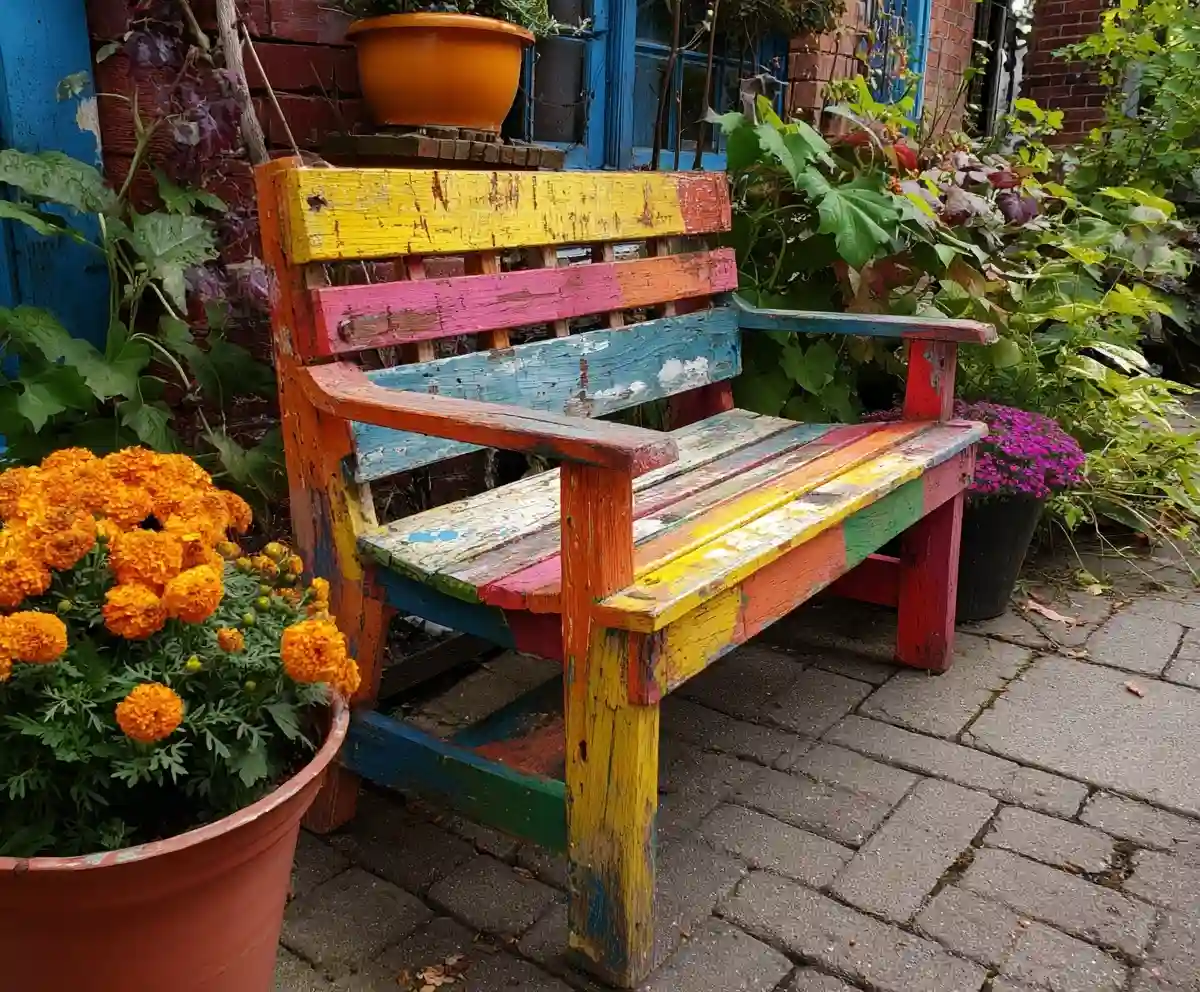
19+ Budget-Friendly Backyard Makeover Ideas
Backyard makeover ideas can turn even the most ordinary outdoor space into a warm, inviting retreat—without draining your wallet.
Read More →
21 Stunning & Simple DIY Clematis Trellis Designs
DIY clematis trellis designs are a beautiful way to blend creativity with function in your garden.
Read More →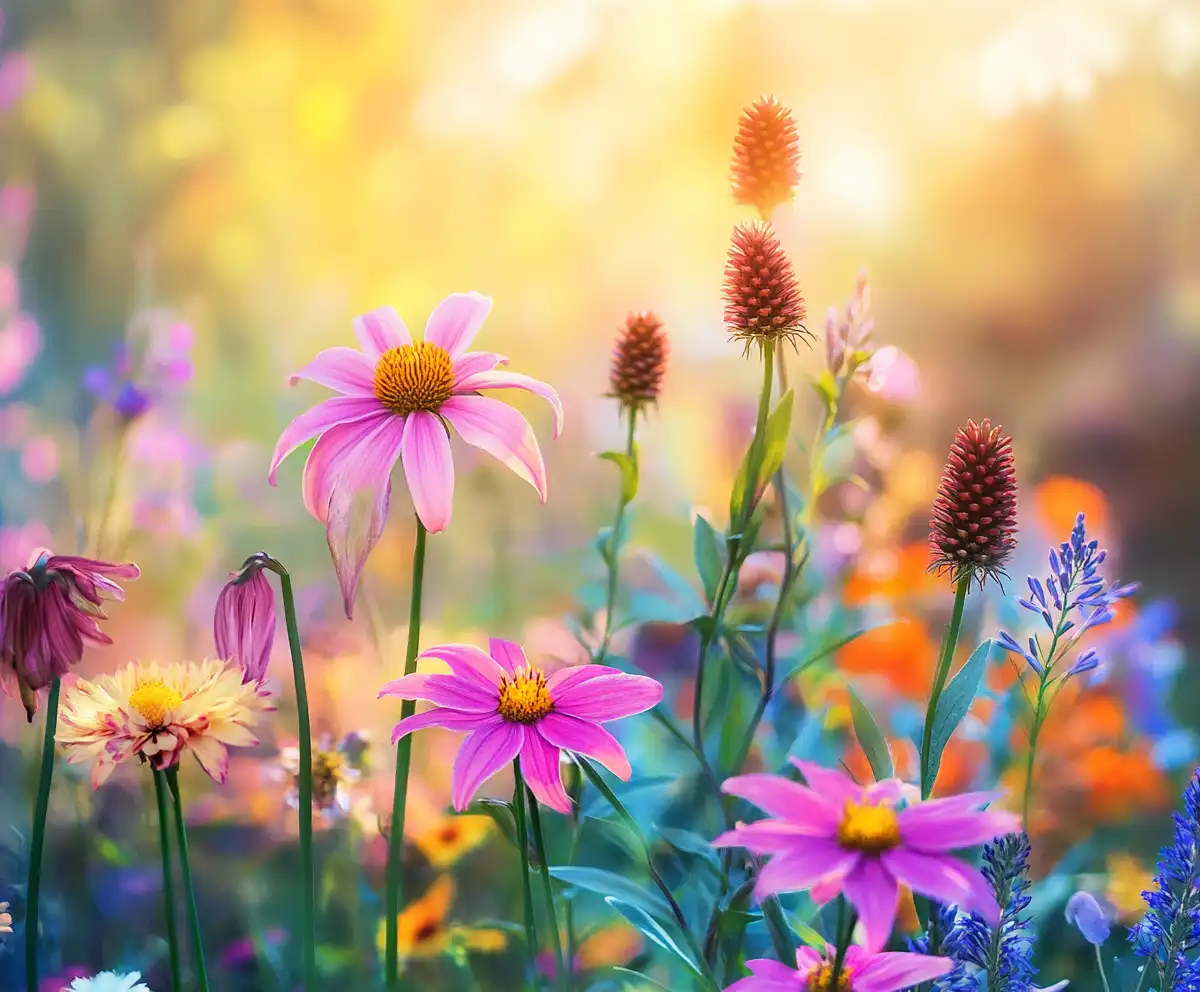
12 Full Sun Perennials That Bloom All Summer
Explore a selection of hardy perennials that flourish and bloom beautifully in full sun throughout the summer.
Read More →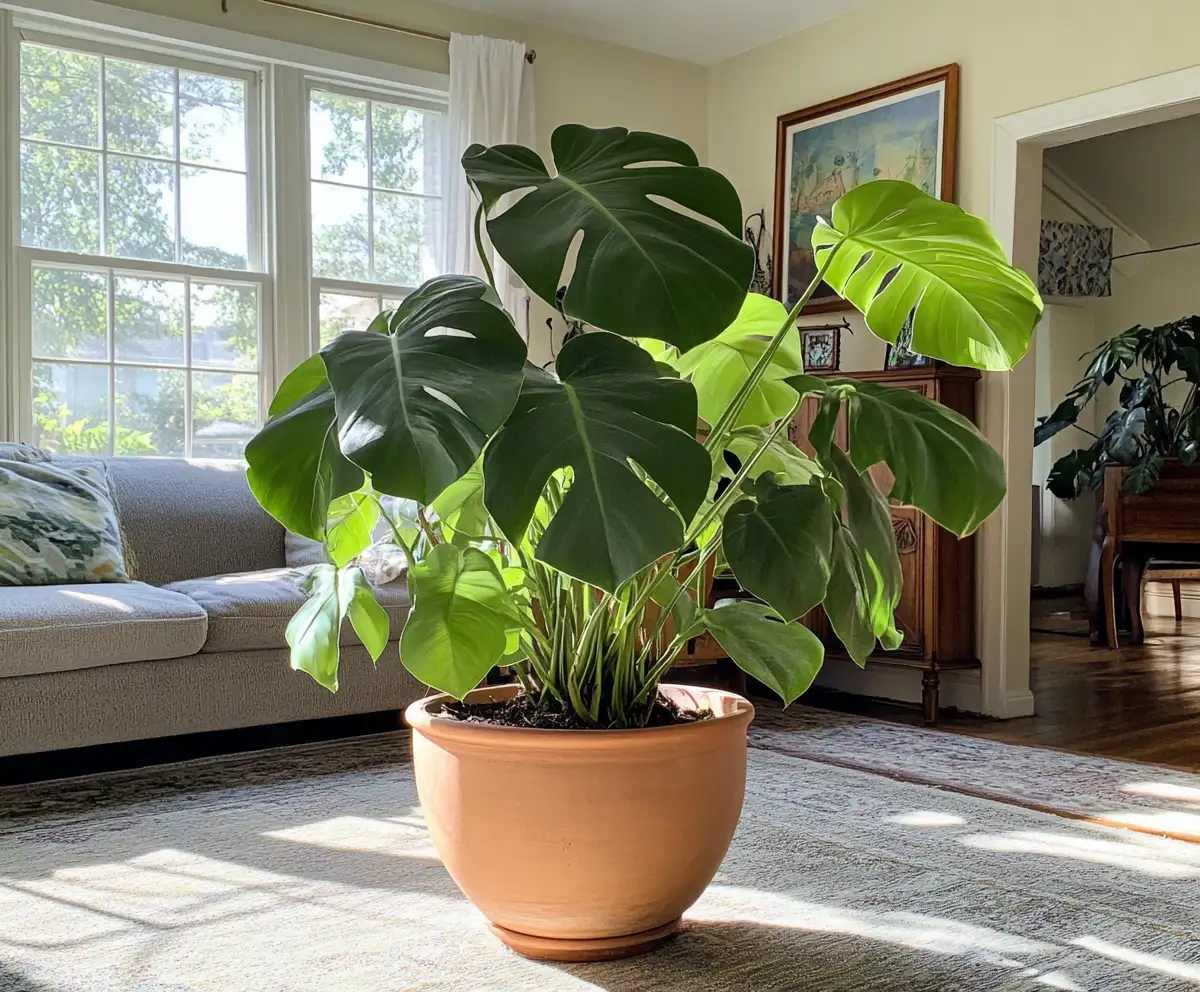
Houseplants for Living Room
Find the perfect houseplants to brighten and purify your living room while adding a touch of nature indoors.
Read More →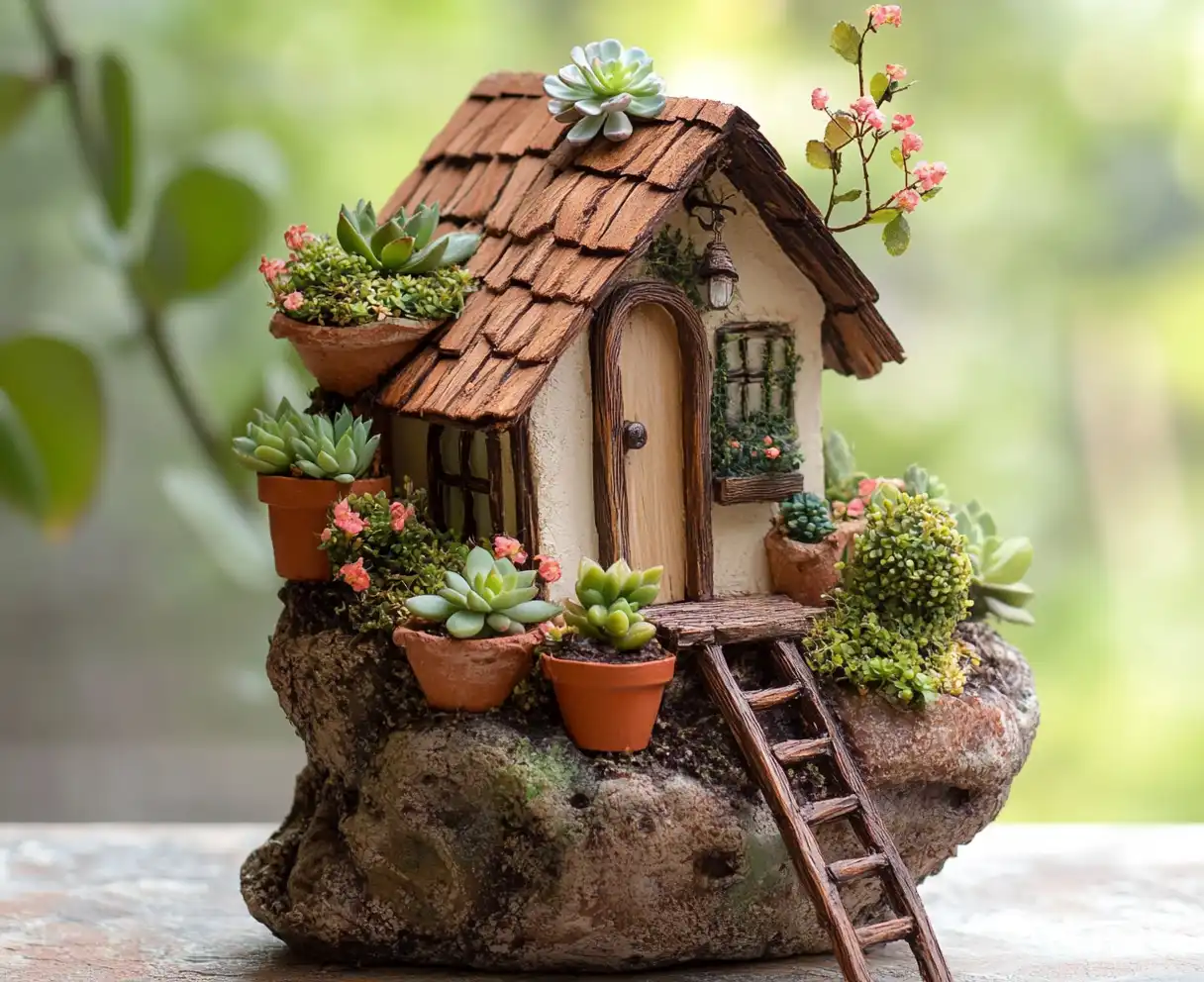
Backyard Play Area for Kids
Create a fun and safe backyard play area for kids with these inspiring design ideas and tips.
Read More →
Top Privacy Trees
Discover top tree varieties that provide natural privacy and enhance your outdoor space.
Read More →
